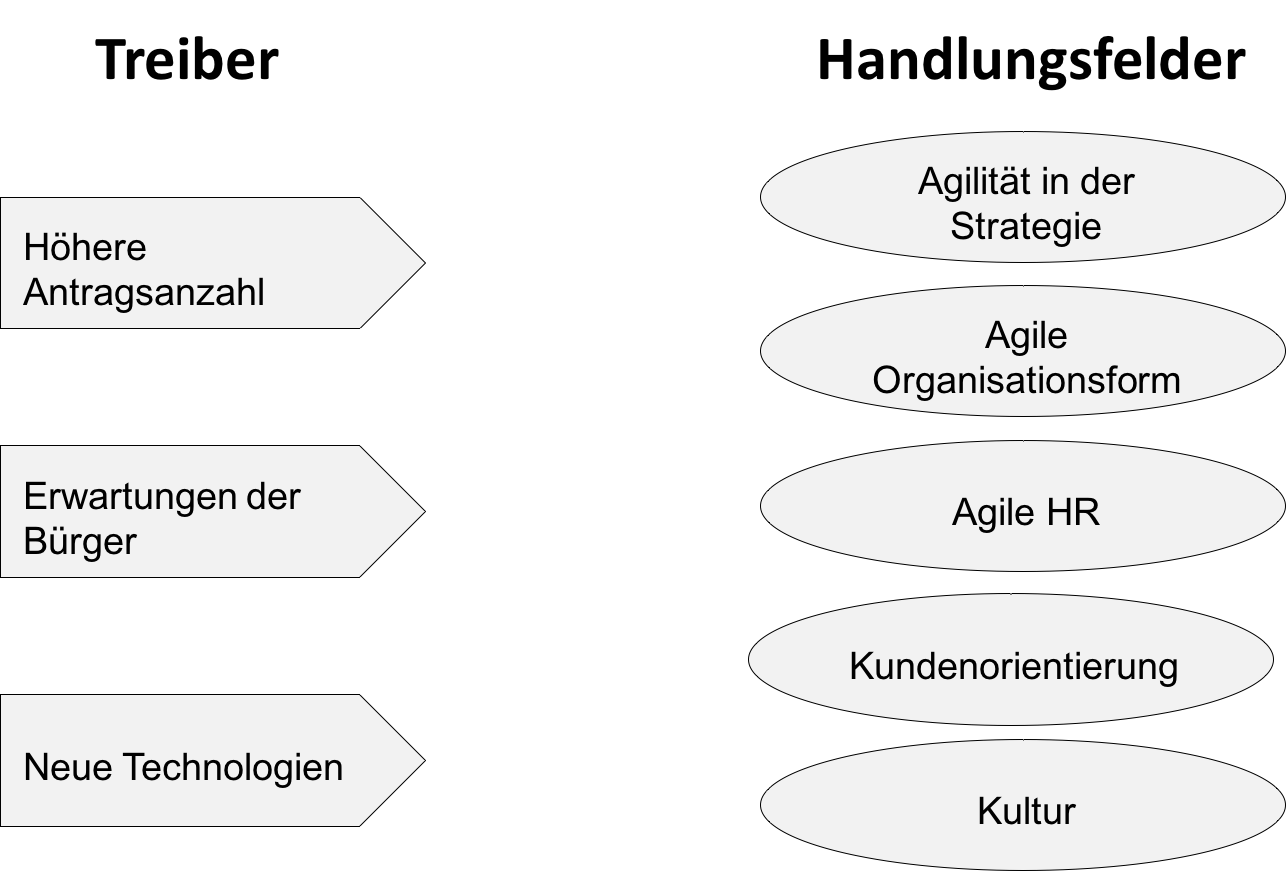For many citizens, authorities and administrations in general are associated with the words boring, dusty and slow. There are probably also few among my readers who are looking forward to going to the registration office or who are longing for the next official visit.
Of course, authorities and their service providers are aware of this fact, which is why digitization is being pushed forward in authorities and more and more IT consultants are being sought for the public sector and, on the other hand, agile methods are becoming increasingly important and the position of agile coach in the public sector is now more important than is asked. In this article, I’ll take a closer look at the keywords agile administration and digital administration.
Agile administration
In the first Google search I found a page that deals extensively with the topic of agile administration. In this blog find the drivers and reasons for one agile Administration, which I briefly summarize in 3 key points:
- large number of refugees,
- Authorities as service providers and
- new technological possibilities.
It is not an open secret that nobody really likes going to an authority and that the potential for agility is very high here. About this says the blog :
Thinking in terms of responsibilities is a central cultural pattern in our administrations. For each task there is a responsible administrative level and in this one responsible authority, office or subject area. Complex tasks – approval of commercial settlements, care of young people in socially disadvantaged families, finally reception and integration of refugees – are broken down as best possible into individual bites that are tailored to the responsibilities (agile-verwaltung.org)
The blog also gives an example that I would like to quote: In one federal state, the State Environment Agency is the competent approval authority for applications for the construction of larger wind farms. However, another 12 authorities are to be involved in this. The questions that arise from the application are divided into 13 seemingly independent packages and assigned to 13 clerks. These clerks usually never see each other.
But the article didn’t give me a lot of answers, which is why I looked further. On the Bearingpoint blog I found a whitepaper that gives 5 levers for agile administration. These are:
- strategic control and resource management
- flexible and adaptive organizational structures
- strategic human resource management
- adaptable and customer-oriented IT
- Culture and versatility
In the first point, the whitepaper calls for strategic and holistic thinking. The whitepaper cites the following as an example: With the continuous target and task control, the Federal Insurance Office introduced an instrument that has already been used successfully for several years. In an annual cycle, tasks are viewed critically on the basis of defined goals and optimization measures are agreed. The implementation is monitored in an implementation controlling.
In the second point, the whitepaper recommends implementing the goals set out in point 1 quickly. The whitepaper gives as an example: Administrative processes are recorded in the National Process Library and made available to other authorities for similar tasks. This way, best practice solutions can be used to learn from one another.
The third point deals with personnel management. Typical HR topics are covered, from recruiting to qualification. Example: The Federal Foreign Office recruits, develops, qualifies and plans the deployment of personnel on the basis of requirement and competence profiles. Requirement profiles describe which performance can be expected of a job holder to what degree for which task. The competence profile shows to what extent the requirements are met and in which area there is still potential.
Customizable IT, which will be discussed in the next paragraph, and the culture of adaptability are still in focus. For more information, see the whitepaper or my book recommendations to digital change. In the following figure I have briefly summarized the drivers and fields of action.

Digital administration
We are on the way from Age of knowledge into the digital age . Everywhere you see advertising and case studies for IT and digitization in the public sector. For this reason I took a closer look at the keyword: digital administration.
The government program Digital Administration 2020 can be found very quickly. Here authorities are supported by the state in digitization. According to the Homepage of the Federal Government The following projects are currently being promoted:
- the portal network with the aim of providing citizens and companies with easy-to-find, secure access to administrative services online,
- the introduction of electronic files (e-files),
- the receipt and processing of electronic invoices,
- the digitization of federal procurement processes,
- the cross-institutional digitization of the legislative process,
- Open data.
Also found on the following page an evaluation report on the progress and successes of the state initiative. But it remains unclear for me and certainly for you as a reader what exactly constitutes a digital administration. The Management consultancy T-Systems provides solutions for digital administration with so-called e-government. So the advice on your blog says: New services such as the electronic identity card (nPA), online citizen service portals or electronic files (e-files), but also joint projects between different areas such as the police or the judiciary, are already providing valuable approaches. The goal is clear: simpler and more user-friendly administrative services as well as more efficient processes in public administration that save costs and time. Citizens, companies and administrations benefit equally from this. Within a digital administration, information is always up-to-date, individual procedures can be processed much faster, and cross-agency collaboration is simplified.
But what does that look like in concrete terms? in the Blog kammunal.de I found a nice example for a digital administration: A vision for digital management: a private buyer purchases a car from a private seller. The seller logs on to the website of the motor vehicle authority, selects his registered car and clicks on “Sale”. Then he uploads the sales contract and registers the buyer. The buyer is called by email to confirm the purchase by means of a digital signature and to pay the administration costs online. Now the seller has to confirm the process again and the next day the vehicle documents for the new car owner arrive in the post office. The administrative effort for buyers and sellers is around ten minutes.
So there is a lot of potential for digitization in advice and numerous digital tools are intended to process applications better and improve the service for the citizens of our country. Of course, I also thought about it and changed the Consulting 4.0 model a little. I believe that virtual chats, full automation and online self-services are great solutions for me in the long run. A chat in particular would be great because you could save yourself going to the authorities and the online entry of applications would be convenient at the same time. Some recommendations can be found in the figure.

Conclusion: There is no shortage of ideas
The above example of buying a car is far more than a fictional scenario – it is already a reality in Estonia. But if you look at Google, you’ll find sentences similar to those in Blog Kommunal.de:
IT expenditures for public administration are extremely high. However, especially in the area of digital services for the citizen, none of this works (Kommunal.de).
You hear these and similar sentences as soon as you ask people about digitization in authorities. On the one hand it may well be headlines like ROBASO in the Federal Employment Agency (60 million euros project stop) or the high daily rates of McKinsey interns at the Federal Office for Migration and Refugees (2700 euros daily rate), on the other hand, I have no insight and do not know exactly the processes and hurdles of the authorities. However, I think that next to the headlines the efforts will show and we will experience more agility and digitization in administrations. Certainly, internal processes have to be broken up and IT systems have to be provided for a high scalability of millions of applications and documents. This is certainly not easy and there is also the shortage of skilled workers, which often forces you to resort to service providers. Issues such as the refugee crisis will certainly have taken up a lot of resources that were normally not planned for this purpose and that German authorities had to master really high challenges in the past year. However, I am confident that we will soon establish the new topics such as e-files etc. in Germany and that there will be significant changes.
To the end: Please answer a short question for me: What do you think is currently more important: Will increased digitization lead to more agility in authorities or do you think that higher agility should first be created in order to be able to tackle digitization?
[yop_poll id=”33″]
[werbung] Verwendete Quellen anzeigen
Business image created by Asier_relampagoestudio – Freepik.com
AGILITÄT IN DER VERWALTUNG – eine einführende Übersicht
https://www.bundesregierung.de/Content/DE/Artikel/2017/05/2017-05-17-evaluierung-regprogramm-dig-verw-2020.html
https://www.t-systems.com/de/de/branchen/public/themen/behoerden/digitale-verwaltung-239204
Agile Arbeitsmethoden: welcher Nutzen für die öffentliche Verwaltung?



